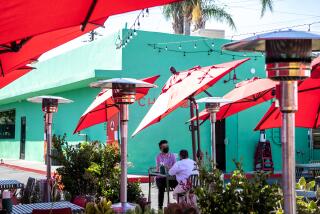Neighbors Opposed : Dancing at Mall Eatery Tripped Up
- Share via
James Tso, owner of the Beverly Center’s Pinafini restaurant, thought his request was simple. To accommodate some private parties and other special events, Tso wanted permission from the city to allow dancing several nights a week in the rear of his ground-floor Italian restaurant.
But on Tuesday, Tso learned nothing is simple at the giant mall when nearby residents get involved. The Beverly Center has been a rallying point for Westside slow-growth advocates since it opened six years ago, and on Tuesday they turned their wrath on Pinafini--and won.
By a 3-1 vote, the Los Angeles Board of Zoning Appeals rejected Tso’s request for a permit to allow dancing, despite a recommendation from a city zoning administrator that Tso was entitled to it. The board, responding to testimony from nearby residents and the Police Department, said the time had come to clamp down on late-night entertainment in and around the popular mall.
Problems Cited
“It has gotten out of hand,” said board President Ilene Olansky. “I don’t think planners ever anticipated (the Beverly Center) would be this popular a draw for young people. . . . To add to that before we get a handle on the problem is not in anyone’s interest.”
Representatives from two homeowner organizations, Councilman Zev Yaroslavsky’s office and the Wilshire Division of the Los Angeles Police Department told the board about problems near the mall, involving traffic, crime, parking and the large number of young people who gather there at night and on weekends. They said they feared that Pinafini, with a dance permit, would become a discotheque catering to youths who, in the words of one homeowner, “raise hell in our front yards.”
Police Sgt. Roger Dowis said there are five discotheques in the Wilshire Division--including two at the Beverly Center--and he described them all as problems. The discotheques, he said, attract teen-agers who are too young to be served alcoholic beverages but who want to drink nonetheless. As a result, some of them park in nearby neighborhoods, drink in their cars, throw bottles in yards and generally disrupt residential areas, he said. Others are served illegally in some of the clubs, he said.
“We end up with numerous minors we have to arrest,” Dowis said. Pinafini was fined $1,500 last year for serving liquor to a minor in 1986.
But Tso told the board that his detractors were overreacting, that their complaints should be directed at existing discotheques, not at his restaurant. He said that Pinafini has not been cited since 1986 and that he has hired an off-duty police officer to patrol the restaurant.
“It is more a restaurant serving professionals and yuppies,” Tso said. “We don’t intend to turn this place into a disco.”
Private Groups
Tso said that he wanted the permit to accommodate private groups that have requested dancing along with dinner. Tso now must apply for a special one-day permit each time he wants to provide dancing, which takes time and is inconvenient, he said. He said he was willing to accept conditions suggested by Associate Zoning Administrator Jack Sedwick, who recommended that dancing be allowed only from 10 p.m. to 1:30 a.m. four nights a week and on just 20% of the restaurant’s floor space.
Sedwick supported Tso’s request, telling the board that “a reasonable amount of dancing would be appropriate” at Pinafini since it would be “incidental” to the restaurant’s primary function--serving food. Sedwick said the city in 1982 granted the Beverly Center a conditional use permit that allows dancing in five restaurants at the mall. He also said three of them have dancing now.
Under the conditional use permit, each restaurant that wants dancing must receive separate approval from a zoning adminstrator. In this case, Sedwick approved the request, but the homeowner groups appealed his decision to the appeals board.
Permits Obsolete
Representatives from the South of Burton Way Homeowners Assn. and the Beverly-Wilshire Homes Assn., which represent residents east and south of the mall, said the neighborhood has changed since 1982. Development of a shopping center, a 10-story hotel and other commercial projects under way near the mall have rendered the original conditional-use permit obsolete, they argued.
“This whole area has changed,” said Harald Hahn, president of the South of Burton Way group. “We are seeing our neighborhoods being destroyed.”
Added Diana Plotkin of the Beverly-Wilshire group: “We are attempting to control the changes.”
The mall’s conditional use permit allows dancing in restaurants on both the eighth and first floors, and board member James D. Leewong said he would probably look differently on a request from a restaurant on the eighth floor.
“There is a big difference having them all on the ground floor with access to the street as opposed to the eighth floor in an enclosed area,” he said.
Even board member Nikolas Patsaouras, the lone member who sided with the restaurant, told the residents: “We know you have a mess there.” But Patsaouras said Pinafini should not be punished because of problems in the neighborhood.
“You are trying to vent your frustration on this restaurant,” he said.
More to Read
Sign up for Essential California
The most important California stories and recommendations in your inbox every morning.
You may occasionally receive promotional content from the Los Angeles Times.










